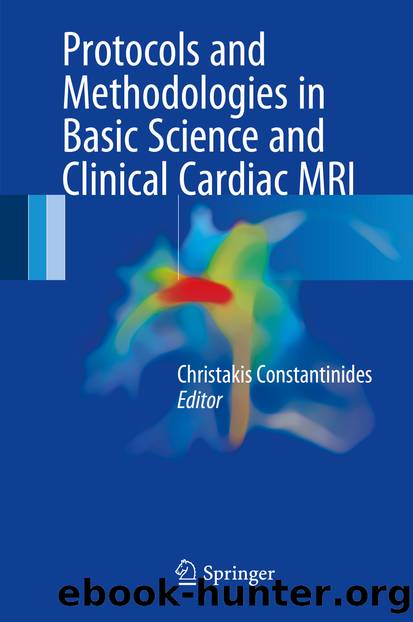Protocols and Methodologies in Basic Science and Clinical Cardiac MRI by Christakis Constantinides

Author:Christakis Constantinides
Language: eng
Format: epub
Publisher: Springer International Publishing, Cham
Accelerated Data Acquisition Methods
In comparison to MRI, data acquisition for MRS is time-consuming. This stems from three main causes: metabolite concentrations are several orders of magnitude lower than the proton concentration of water in the tissues and often have long T1 values; non-proton nuclei are significantly less MR sensitive than protons; and localized CSI-type experiments require collection of an extra data dimension requiring an extra phase encoding step. For ex vivo perfused heart studies, these long data acquisition times are not necessarily a problem. However, as preclinical in vivo MRS is necessarily carried out using general anaesthesia, the length of time for which the animal can safely be keep anaesthetized, and still recover afterwards, is limited. Until relatively recently, this limitation mean that the MRS acquisition time was curtailed, resulting in compromises of either SNR or spatial resolution.
Use of acquisition weighting and density weighting of k-space has been suggested as a way to accelerate CSI data acquisition by optimizing the regions of k-space that are sampled [34]. In acquisition weighting, for example, the number of averages acquired at each point in k-space can be varied using a Hanning function such that at the centre of k-space, where most SNR is derived, more averages are acquired with fewer averages being acquired at the edges of k-space. This necessarily degrades spatial resolution. However, by increasing the number of phase encoding steps (i.e. sampling further out into k-space) whilst keeping the total number of FIDs constant, this loss in spatial resolution is compensated whilst simultaneously improving SNR. The use of a Hanning weighting function means that the point-spread-function of the resulting image has significantly reduced side-lobes, thereby reducing signal contamination from neighbouring voxels. Density weighting is a similar approach in which a uniform number of averages is acquired from each sampled point in k-space, however the sampling density is high in the centre of k-space, and lower at the edges.
Optimized single-voxel spectroscopy has been attempted in clinical cardiac spectroscopy in order to define arbitrarily shaped spectroscopic voxels. Techniques such as spectral localization by imaging (SLIM), spatial localization with optimum pointspread function (SLOOP), and spectroscopy with linear algebraic modelling (SLAM) aim to use linear combinations of phase encoding steps in order to reconstruct spectroscopic signals that originate from a defined region of the sample [40, 87, 91, 92]. By defining the voxel to coincide with the annular left ventricular myocardium, it is possible to maximize the amount of myocardial tissue in the voxel improving SNR, and minimizing the amount of partial volume contamination from neighbouring tissues. These methods have not yet found much employment in preclinical spectroscopy.
The use of multiple actively-decoupled RF receiver coils, in conjunction with an actively decoupled volume coil, can also be used to accelerate spectroscopic data acquisition, analogous to their use in imaging. Multi-coil spectroscopy is being applied in clinical cardiac spectroscopy, particularly for 31P spectroscopy at high B0 [78]. Whilst multi-channel receivers are becoming more common in preclinical scanners, the use of such acceleration for preclinical cardiac spectroscopy is still in its infancy.
Download
This site does not store any files on its server. We only index and link to content provided by other sites. Please contact the content providers to delete copyright contents if any and email us, we'll remove relevant links or contents immediately.
| Administration & Medicine Economics | Allied Health Professions |
| Basic Sciences | Dentistry |
| History | Medical Informatics |
| Medicine | Nursing |
| Pharmacology | Psychology |
| Research | Veterinary Medicine |
Dynamic Alignment Through Imagery by Eric Franklin(4119)
Body Love by Kelly LeVeque(3017)
Barron's AP Calculus by David Bock(1780)
EMT Exam For Dummies with Online Practice by Arthur Hsieh(1654)
The Juice Lady's Remedies for Asthma and Allergies by Cherie Calbom(1607)
Fitness Walking For Dummies by Liz Neporent(1532)
Flight by Elephant(1487)
Extremes: Life, Death and the Limits of the Human Body by Fong Kevin(1485)
McGraw-Hill Nurses Drug Handbook by Patricia Schull(1466)
The Natural First Aid Handbook by Brigitte Mars(1433)
Tell by Major Margaret Witt(1381)
Skin by Unknown(1372)
Seeing Voices by Oliver Sacks(1362)
Born to Walk by James Earls(1284)
The Yoga Bible by Christina Brown(1264)
Cracking the Nursing Interview by Jim Keogh(1254)
First Aid for Colleges and Universities (10th Edition) by Mistovich Joseph J. & Limmer Daniel J. & Karren Keith J. & Hafen Brent Q(1233)
The Advantage by Lencioni Patrick M(1172)
Living Ready Pocket Manual - First Aid: Fundamentals for Survival by James Hubbard(1163)
